Flaky Sourdough Croissants – With Step by Step Instructions
A step-by-step recipe for easy sourdough croissants. The end result is buttery, flaky pastries, sure to impress.
Sourdough croissants are deliciously buttery, flaky and once you make them you can’t help but feel darn proud. Making croissants with the sourdough starter is a pretty drawn-out process, but it is not actually difficult. In this post, I will show you step by step how to make this sourdough pastry recipe.

The process is spread out over two days so the main thing you need is time.
These croissants are best made in an environment where the room temperature is not too hot. The trick to flaky layers in the dough is to keep the butter cool as it is rolled into the dough. If it melts into the dough, it won’t be laminated correctly.
If your room temperature is above 25°C/77°F you may struggle to keep the dough and butter cool.
The starter
In the morning, feed your sourdough starter. You’ll need 150g of fed and active sourdough starter at 100% hydration for these sourdough croissants. 100% hydration means there are equal weights of flour and water used when feeding the starter.
To get great and consistent results it’s important that you use an active starter that has a low acid content.
If you refresh your starter regularly and use a small amount of seed starter each time, this can slow the acid build-up.
I like to use the feeding ratio of 1:2:2, (1 part starter, 2 parts flour, and 2 parts water measured in weight).
I refresh my starter like this very often, in a clean jar. This brings a fairly small amount of seed starter into the new mix, with double the amount of fresh flour and water.
For this dough, it could be 40g starter, 80g flour, and 80g water. This will make approximately 200g starter. 150g can be used for the dough, and the remaining starter can be fed again 1:2:2 and stored the next time you need it. See more about maintaining a starter.
At a room temperature of between 21-23°C, a starter that’s ready will double, if not triple, easily within 6 hours at that ratio. Use your starter before it passes its peak and starts to collapse. If used after this point, it will likely be too exhausted and acidic to give good results. Read more about acid content in starters.

The pastry dough
When the starter is ready to use, combine the flour, water, salt, sugar, sourdough starter, and butter in a bowl. Mix it together by hand to create a sticky ball of dough.
Give it a knead for 5-8 minutes to create a smooth ball, though it will still be sticky. Place it in a greased bowl.
Leave the dough out for 3 hours to ferment, ideally at room temperature between 23-25°C/74-77°F. If your room is cooler than this, leave it for 4 hours. The dough should be slightly puffier after the ferment.
Afterward, transfer it to the refrigerator overnight.
At this point, leave out 250 grams of butter for tomorrow’s step so it is at room temperature for when you need it.
Butter Packet
In the morning, take the butter that was left out overnight and mix it with some flour to create a butter mixture that is nice and malleable.
Roll this butter mixture out between two sheets of baking paper into a rectangle of about 15 x 20cm (6x8inch.)
Place the butter in the fridge for a few minutes to cool. Ensure it is cool but still pliable.
If the butter is too cold and stiff, it’s going to shatter in the dough when it’s rolled out which can create uneven layers. Aim for the butter and the dough to be similar consistencies.
Gauging the exact temperature of the butter packet so that it is a similar consistency to the dough is something that gets better with practice.
Lamination
Now, on a floured bench, roll out yesterday’s dough into a 20x40cm(8x16inch) rectangle.
Once the butter is cool again, place it in the middle of the dough. Bring the top of the dough down and the bottom of the dough up to meet in the middle and tuck in the butter.
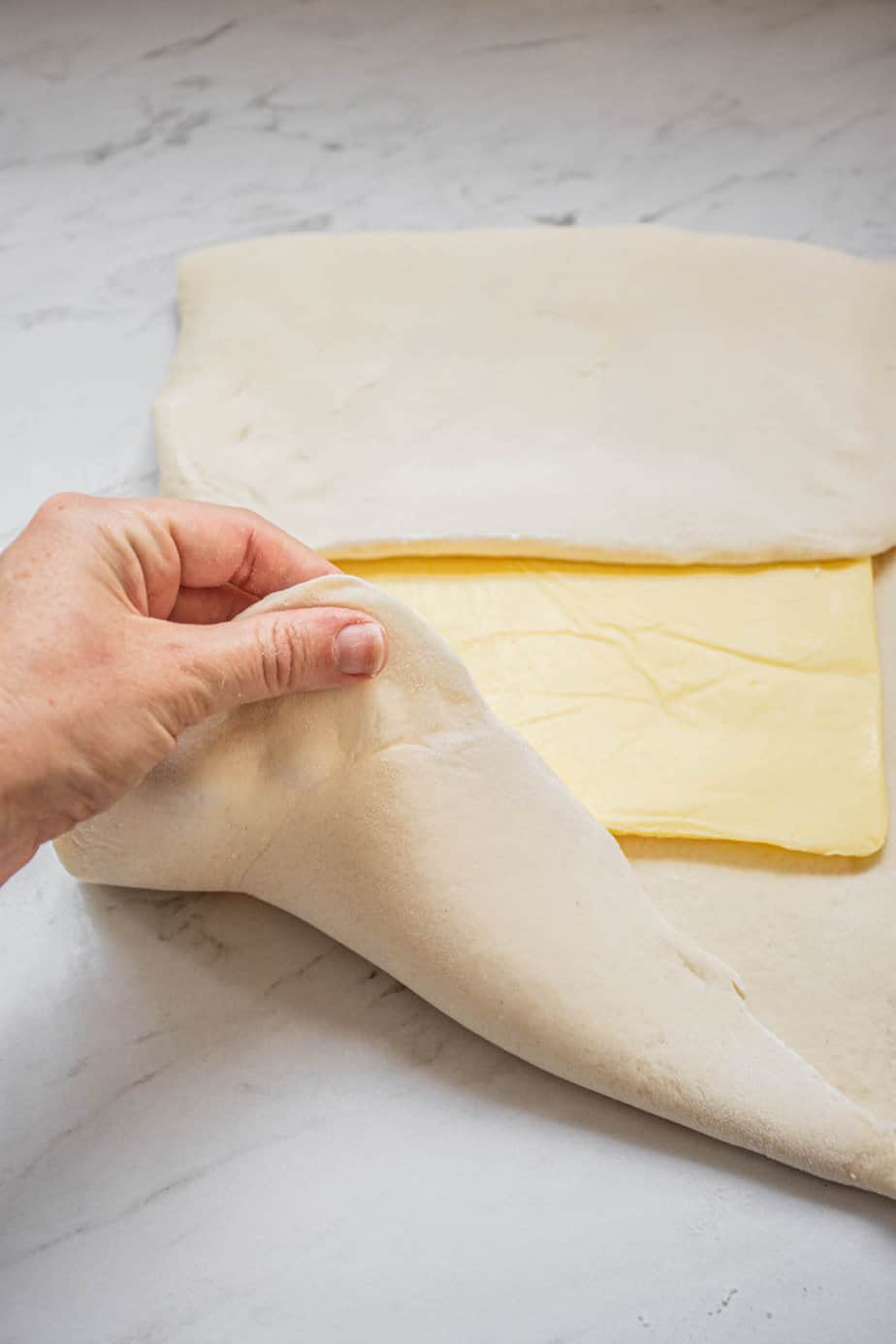
Turn the dough a quarter turn. Use a rolling pin to gently push on the dough to help disperse the butter.
The butter should just be cool but not rock hard. Keeping the butter and the dough at similar consistencies is key. If the butter is too firm and brittle it won’t incorporate into the dough well.
However, ensure it doesn’t warm and softens too much. Cold butter is what will give the flaky layers in the croissants. If the butter melts into the dough, you’ll end up with bread-like croissants with no layers.
Fold 1
Roll this dough out in front of you into a rectangle that’s around 25x50cm (10x20inch), focus on lengthening the dough rather than making it wider. While rolling, check that the dough isn’t sticking to the bench and dust with flour if it is.
Fold the dough like a pamphlet by bringing the top third down to the middle and then bringing the bottom third up overtop.
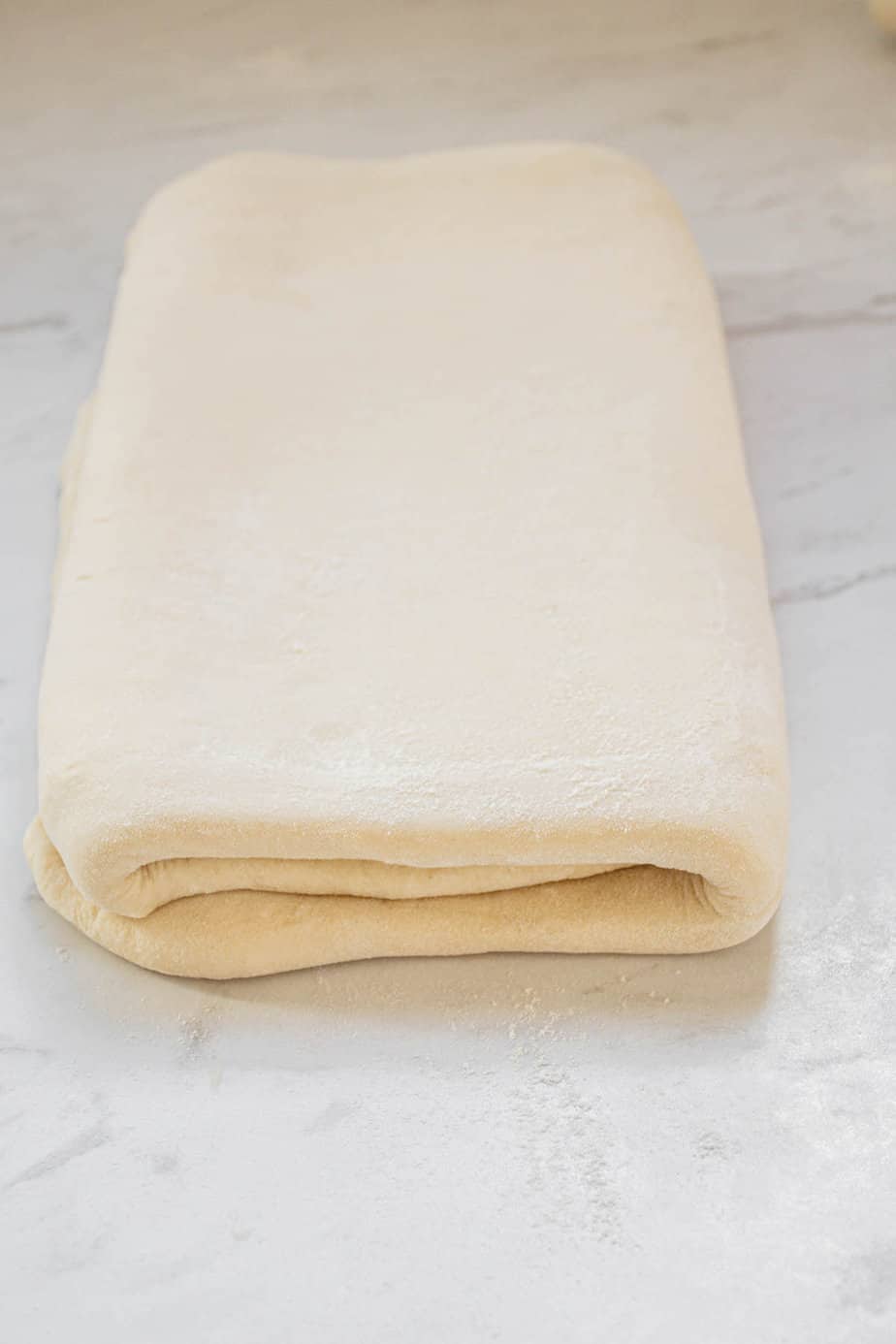
Wrap the dough up (I use the baking paper used for the butter) and let the dough rest for 30 minutes in the fridge. If your kitchen is on the cold side, the dough can rest on the bench.
Again, you want the butter and the dough to be similar consistencies, but don’t let the butter warm up.
Fold 2
Turn the chilled dough 90 degrees and roll it out in front of you into another 25x50cm (10x20inch) rectangle. At this point, you can cut off any scraggly edges, which will help give you more even layers later on. Repeat the folding process. Place it back in the fridge for 20-30 minutes.
Fold 3
Repeat this step once more. After this fold, chill the dough for at least 2 hours.
Shaping
Roll the chilled dough into a 28x60cm (11x24inch) rectangle.
Mark 5cm (2inch) marks along both lengths of the dough rectangle. Use a pizza cutter or large knife to cut triangles that connect the marks from the top to the bottom. Using a ruler can really help keep your lines straight.

Make a little cut in the bottom of each triangle and stretch it out. Then roll the triangles up tightly, starting from the bottom and rolling to the tip. You can bed the ends of croissants a little to make a crescent, or leave them straight.

You can also make pain au Chocolat with croissant dough or Cruffins and Danish pastries.
Leave the rolled croissants to proof on parchment paper-lined trays for around 4 hours at a temperature between 23-25°C/74-77°F. They should become puffy and jiggle when the tray is gently shaken. The layers in the croissant should be visible.
You can brush the croissants with a little water to stop them from drying out or create a humid and warm spot by placing the croissants in a turned-off oven next to a cup of hot water.
Ensure the butter in the croissants doesn’t melt or it will ruin the layers.
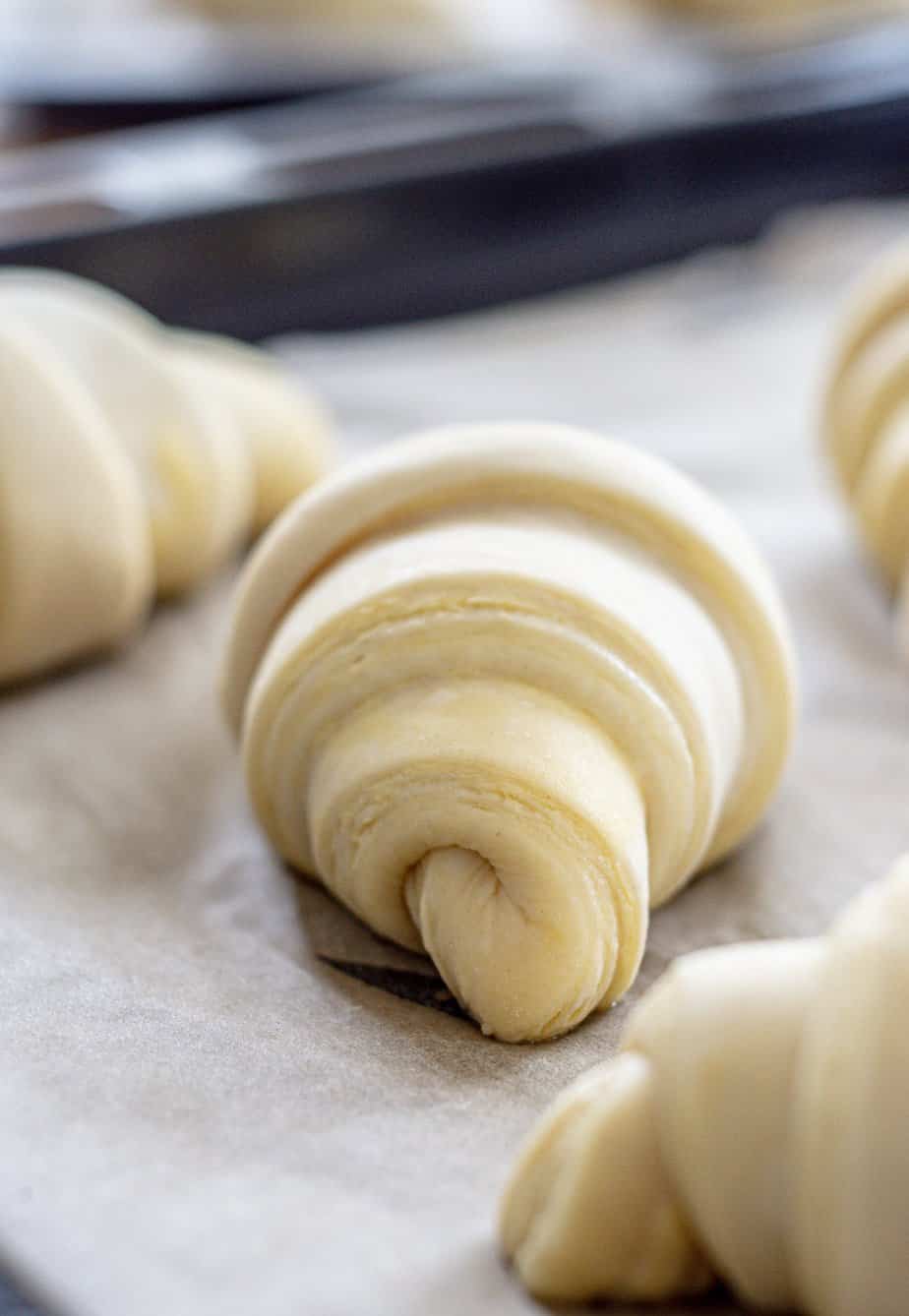
Baking
The croissants can be baked once they have puffed out, or they can be refrigerated if you want to bake them in the morning. The extended fridge time will increase the sour flavor.
Preheat the oven to 205°C/400°F. Brush the croissants with egg wash.
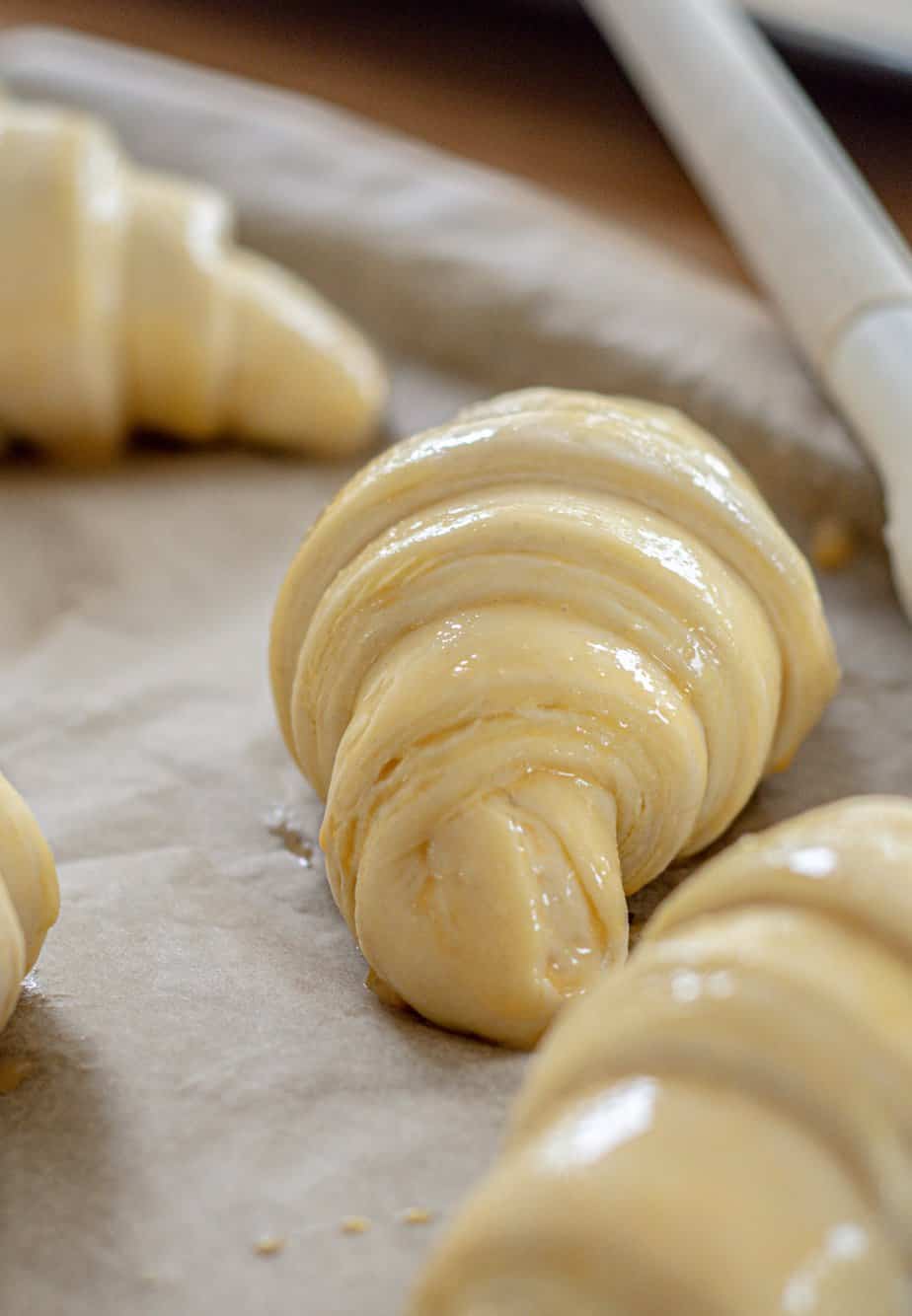
Bake them in a hot oven for around 20 minutes until deeply browned. If they are browning too quickly, you can turn down the oven temperature a bit.
Storing
Croissants are great served fresh on the day they are baked. The layers in the croissants will be most prominent if the croissant has cooled down to room temperature before slicing.
Leftover croissants can be stored in an airtight container at room temperature for up to 4 days, or frozen for up to three months.
Freezing croissant dough
Unbaked croissants can be frozen after they have been shaped and proofed. This way they have already done all their rising and can be baked from frozen.
I have a Youtube video on sourdough croissants however it has been a few years since this video was made and my technique and methods have slightly changed.

Related recipes
Try these other sourdough recipes –
- Easy sourdough focaccia
- Chocolate Sourdough Bread
- Sourdough garlic knots
- Cruffins with sourdough starter
- Sourdough fougasse
Love lamination? Try this inverse puff pastry, or if you’re short on time here’s a rough puff pastry!

Step by Step Sourdough Croissants
An easy sourdough croissant recipe. Makes between 10-12 croissants, depending on size.
Ingredients
Starter (makes approx. 200g starter. Leftover started can be fed and used for the next time you bake)
- 40g starter
- 80g flour
- 80g water
Dough Ingredients:
- 450g all-purpose flour
- 1 tsp salt
- 40g sugar
- 230ml water
- 150g doubled sourdough starter
- 50g unsalted butter, room temperature
Butter packet:
- 250g unsalted butter, room temperature
- 1 1/2 Tablespoons flour
Egg Wash
- 1 egg + 1 tbsp water
Instructions
Starter
- In the morning, feed your starter by combing the starter, flour, and water in a bowl and mixing it until well combined. Tip it into a clean jar or glass and let it double or triple.
The dough
- Prepare the dough by mixing together all the dough ingredients and using your hands to form a sticky dough ball. Knead the dough on the bench for 5-8 minutes until you create a smooth ball.
- Cover the dough in a greased bowl, covered with a damp towel. Leave the dough out for 3 hours to ferment, ideally at room temperature between 23-25°C/74-77°F. If your room is cooler than this, leave it for 4 hours. The dough should be puffier after the ferment.
- Place the covered bowl in the fridge overnight.
Laminating
- In the morning, mix 1 1/2 tablespoons flour and 250g butter. Spoon the mix onto parchment paper and place another sheet on top. Roll the butter into a rectangle of about 15 x 20cm (6 x 8 inches). Place the butter in the fridge for around 10 minutes so it is cool. Ensure it is cold but still pliable. Aim for the butter and the dough to be similar in consistency.
- Take the dough from the fridge and, on a floured bench, roll it into a 20x40cm(8x16 inch) rectangle.
- Once the butter is cool again, place it in the middle of the dough. Bring the top of the dough down and the bottom of the dough up to meet in the middle, and tuck in the butter.
Fold 1
- Turn the dough a quarter turn. Use a rolling pin to gently push on the dough to help disperse the butter. Roll this dough out into a 25x50cm (10x20inch) rectangle, and focus on lengthening the dough rather than making it wider. While rolling, dust the dough with flour to stop it sticking to the bench.
- Brush away the excess flour from the dough. Fold the dough like a pamphlet by bringing the top third down to the middle, and the bottom third up overtop.
- Wrap the dough up (I use the baking paper I used for the butter) and let the dough rest in the fridge for 30 minutes. *If your kitchen is colder, the dough can rest on the bench. However, it is important not to let the butter melt or warm up.
Fold 2
- Turn the chilled dough 90 degrees and roll it out in front of you into a 25x50cm (10x20 inch) rectangle. At this point, you can cut off any scraggly edges, which will help give you more even layers later. Repeat the folding process. Place it back in the fridge for 20-30 minutes.
Fold 3
- Repeat this step once more. After this fold, chill the dough for at least 2 hours.
Shaping
- Roll the chilled dough into a 28x60cm (11x24 inch) rectangle on a floured bench.
- Mark 5cm (2 inches) marks along both lengths of the dough rectangle. Use a pizza cutter or large knife to cut triangles that connect the marks from the top to the bottom. Using a ruler can help keep your lines straight.
- Make a little cut at the bottom of each triangle and stretch it out. Then, roll the triangles up tightly, starting from the bottom and rolling to the tip. You can bed the ends of croissants a little to make a crescent or leave them straight
- Leave the rolled croissants to proof on parchment paper-lined trays for around 4-5 hours at a temperature between 23-25°C/74-77°F. They should become puffy and jiggle when the tray is gently shaken. The layers in the croissant should be visible.
- You can brush the croissants with a bit of water to stop them from drying out or create a humid and warm spot by placing them in a cold oven next to a cup of hot water. Ensure the butter in the croissants doesn't melt or it will ruin the layers. Don’t place the cup of hot water underneath the tray of croissants, or it’ll make the bottom of the tray too warm.
Baking - The croissants can be baked once they have puffed out or refrigerated if you want to bake them in the morning. The extended fridge time will increase the sour flavor.
- Preheat the oven to 205°C/400°F.
- Mix the egg and water together in a small bowl. Use a pastry brush to brush the croissants with egg wash.
- Bake the croissants for around 20 minutes until deeply browned.
Storing
- Croissants are great served fresh on the day they are baked. The layers in the croissants will be most prominent if the croissant has cooled down to room temperature before slicing.
Notes
- If the croissants leak a lot of butter in the oven, the dough may be under-proofed. The texture of an under-proofed croissant can be gummy and appear undercooked.
- If the croissants take on a bread-like texture, the butter may have melted into the dough during lamination. It is important it stays cool while it is rolled in.
Freezing croissant dough
Unbaked croissants can be frozen after they have been shaped and proofed. This way they have already done all their rising and can be baked from frozen.
Recommended Products
As an Amazon Associate, a Mighty Ape affiliate and member of other affiliate programs, I earn from qualifying purchases.
Nutrition Information:
Yield: 10 Serving Size: 1 gramsAmount Per Serving: Calories: 526Total Fat: 26gSaturated Fat: 15gTrans Fat: 0gUnsaturated Fat: 9gCholesterol: 83mgSodium: 246mgCarbohydrates: 64gFiber: 2gSugar: 4gProtein: 9g
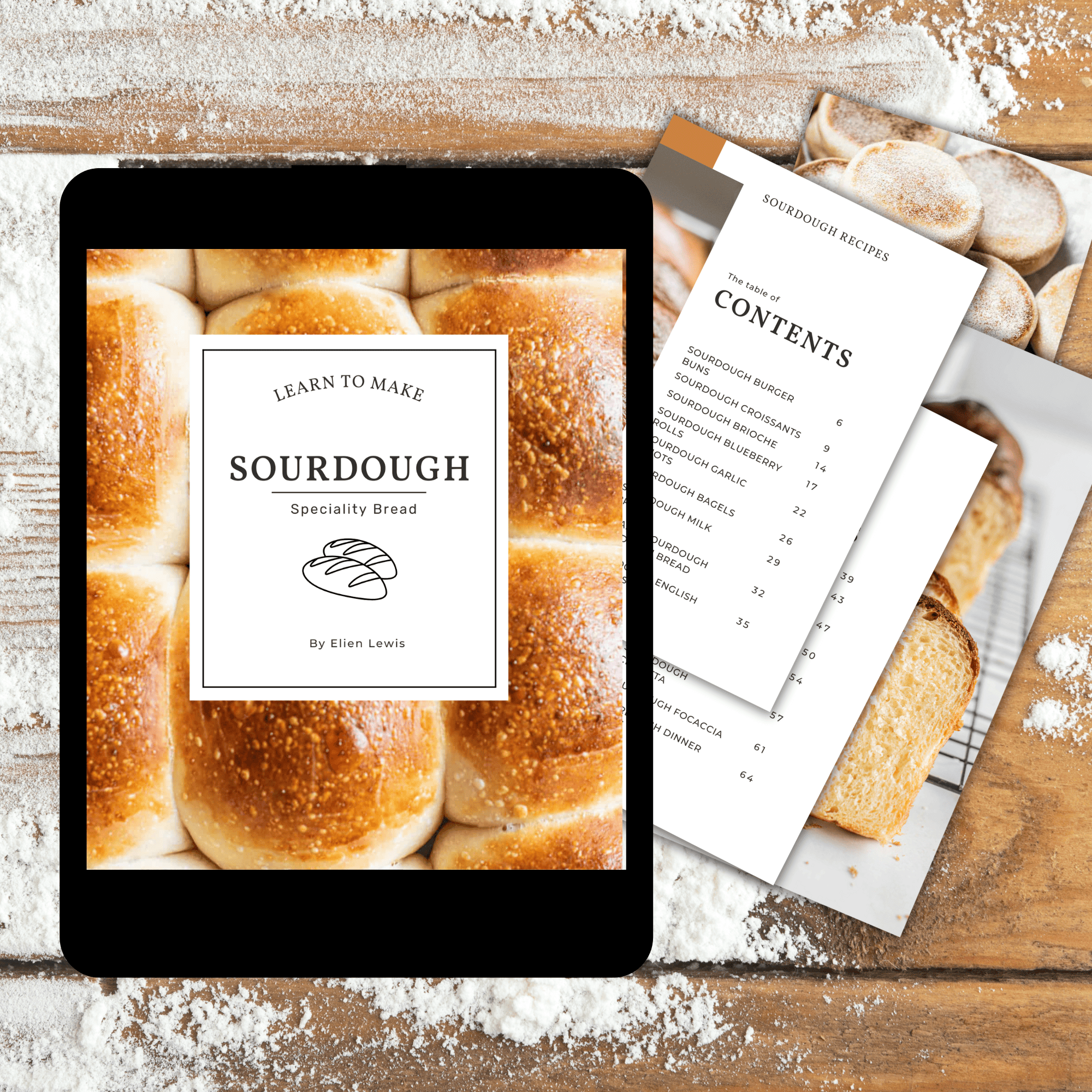

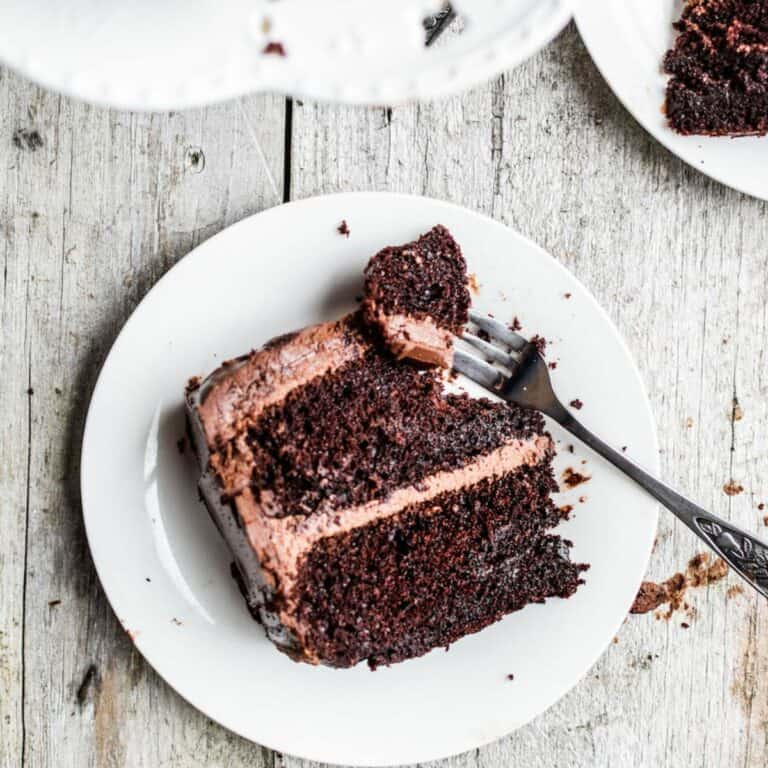
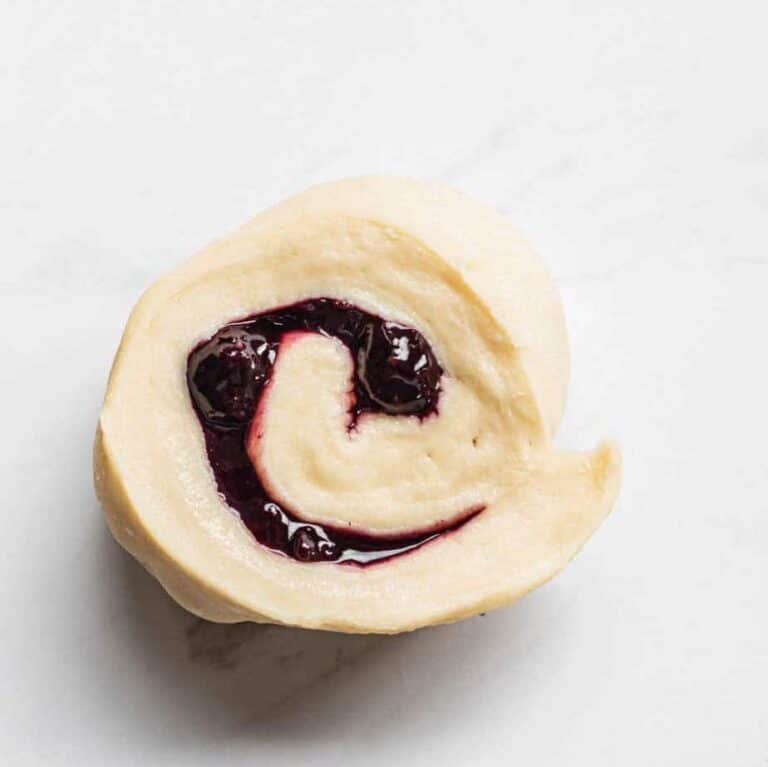
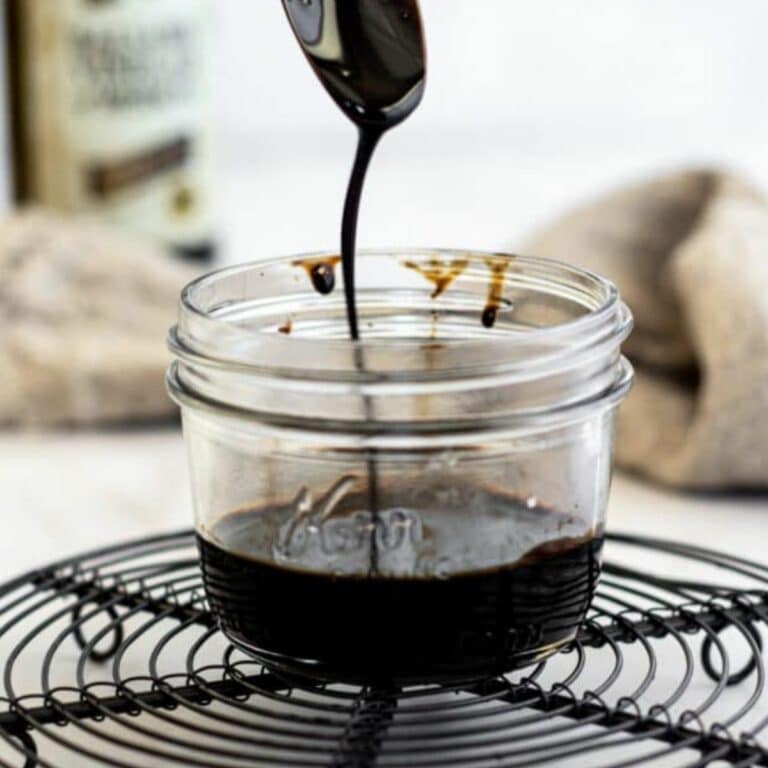



I have tasted croissants in Frace, Belgium and in French cafes in Wellington and I can honestly say that your croissants are the best!! They taste divine ! Right texture, beautiful color and crunchy and the sweetness is just perfect 👌
Thank you so much!
……looks really great, I must try them❤️
Thank you!
How many do you make with this batch size,please?
Hey it makes 12 medium croissants 😊
I’m making a half batch because I am a very experienced eater, and live alone. One day soon I will have maxed out my skin and pop.
Why do I have to retard them till a third day? Can I cook them tomorrow evening because I will be getting up very early on Monday to bake otherwise. I’m telling you I don’t mind starting the second day early Sunday, so the finished rolls are able to have some fridge time tomorrow, and then bake tomorrow night. I will report back if they are successful, otherwise I will be sulking.
Hey I think it would be fine to combine the process into two days, the cold retards can be shortened. The most vital steps are the folding of the butter and that last ferment on the bench before they go in the fridge before baking.
Would love to hear how you go with the shortened time 😊
Yay, they are amazing! I reduced the overnight fridge retard to 2 hours and baked from cold. They are gorgeous and so flakey. Thanks for colluding with me 🤗. I tagged you in my insta.
Yay so pleased and thanks for letting me know!
My oh my!!!
Thank you for your generosity! The best croissants I’ve ever tried, made with my own hands! What a satisfaction! So many people keep their secrets, and you’re just so generous!
Thank you!
Can I freeze them before baking? And the baguette? Can You freeze them?
Thank you so much! You can freeze the croissants before baking, through follow the recipe right through first, until the baking point, then freeze. And you can freeze the baguettes once baked, and defrost them in the oven. 😊
When you say “strong flour”, what type of flour do you mean? I’m using bread flour for my first try but I have all purpose more readily available. Thanks!
All purpose with a protein level of at least 10% works just fine. I wanted people to avoid using cake flours with 8-9% protein levels.
Thank you! Is bleached all purpose ok? (Husband grabbed a 25lb bag of bleached all purpose when stores were emptied last week because of our shelter in place!)
Bleached isn’t the ideal choice as it lends itself more to softer cakes and muffins and such, but it’ll still work
Last question! 🙂 can I freeze part of the batch of croissants prior to baking? If so, at what point is the best time to freeze some of them?
Hey I have since tested the best time to freeze the dough and it works best once the croissants have proofed for their last time and spent the night in the fridge.
Then I froze them and baked straight from frozen. 👍
Can I use a white whole wheat flour?
Yup ☺️
I’m making my second batch now and have to say these are the best!! I have mixed results with sourdough baking (working out the kinks with a new-ish starter) but these were fluffy and perfect. The layers were beautiful. I think these croissants are one of the tastiest things I’ve ever put into my mouth! Thanks for this fun and approachable recipe for something I’ve always considered way beyond my talents.
I’m so pleased you loved the recipe! 😁😁
Has anyone forgot to put the dough from step 1 into the fridge over night?? I woke up at 5 and put the extremely proofed dough into my fridge!
These turned out beautifully on my first attempt. My only regret is not making more chocolate croissants 🙂 Thanks so much for this wonderful recipe.
That’s great! So glad you enjoyed it 😁
How long can the dough sit in the fridge on night 1? I am making the dough now. So it will go into the fridge around 630pm. I don’t want to start rolling or messing with the butter until tomorrow afternoon though as i have work in the morning. Would i be okay to leave in the fridge until 2 or 3? a total of 20 hours?
Hey, yup the dough is fine to go in the fridge until then 🙂
These look amazing! I have only salted butter, and with our current quarantine am not so optimistic I will get to the store anytime soon… would salted butter work or would it cause an issue for the rise? Thank you!
Salted butter is just fine to use 🙂
Thanks for the video! Amazing and it’s giving me confidence to give the recipe a try! They look absolutely beautiful!
hi there, keen to try these. I note your comment above that this recipe makes 8-12 … I really don’t want such a big batch. do you think it would be OK to halve the ingredients to make a smaller batch? or could I freeze them? thank you!
Hey you could halve the dough, or if you want to freeze them, follow all the steps right up until baking point, and then you can freeze them ☺️
thanks so much, will try it out!
Hi, going to bake some of the ones I have frozen. Would you increase oven temp or cook for longer? Thanks!
I didn’t defrost them before baking so they took a wee bit longer but I still gave them the initial hot oven temp. You may just need to watch them and decrease it if they’re browning too fast 😊
Hello there, going to try your recipe today-tomorrow. You say it makes about 12 medium ones, what’s medium? I have a few good eaters here and want to gift some for mother’s day, so I want to make sure I have enough for my family and to give away. Thank you.
Love love love this recipe! I have followed your instructions for making the sourdough starter and now my first real recipe was these scrumptious croissants! I made plain, chocolate and almond ones, they are crisp and flaky and delicious- streets better than supermarket ones! Had to give half of them to the neighbours so that I wouldn’t scoff the lot myself! My only regret is that I didn’t make more almond ones!
Very successful treat for Mother’s Day thank you. Will definitely do them again now I know how good they are. Video adds to the written just to boast confidence that I was on track.
Thank you.
I’m so glad you liked them! 😃
Your website and videos have given me new creative life! Thanks so much for your simple instructions and incredibly thoughtful step by steps. I have spent so much time on so many blogs, and I must say yours has the least amount of pretension and fuss. You treat baking like an uncomplicated, casual, beautiful art, not like the delicate exacting anxiety inducer that it actually is! Much appreciated.
I am wondering if after the last fold, the 2 hour chill can become an overnight chill, and then 4-5 hr proofing in the next day before a second overnight transfer.
I started with an active starter today so skipped the Day 1 overnight, but am now looking down the barrel of staying up all night (new baker here still working out how to time out my days!!) in order to give it the rectangle roll out….
Thanks for taking the time to comment! I am learning a lot through your responses to everyone’s questions in the comments sections as well.
Hey Judy, thank you so much! And it can become an overnight chill instead of a two hour one 😊😊
oh no! I made my dough to early in the day, I will have to stay up all night because the first 8-10 hour rise is at noon! Can I refrigerate the dough till morning for a slower rise so I’m not up baking till midnight?
I’m unsure what 8-10 hour rise you mean? Day one once the dough is made, only has a small bench proof before being refrigerated. This fridge period can definitely be extended until you’re ready to laminate and roll the croissants 😊
When I make pastry dough, usually I have to turn the dough between each “flattening/folding”. By turning, I mean one quarter turn like from 3 o’clock to 6 o’clock. Do you do that too with your recipe ?? Thank you ! I can’t wait to have them for Sunday’s breakfast.
Hey yup the dough is turned 90 degrees each time it’s rolled out again 🙂
I’ve always been so intimidated by croissants- but I made these yesterday and I’m amazed! They came out beautifully. Thank you for your detailed instructions! Wonderful recipe
So glad you enjoyed them! 😄
Hi! I’m very much looking forward to try these! Just wondering – as the recipe says it makes 12 – can you freeze some of the croissants and then bake them straight from frozen later?
Hey you can, but follow the recipe all the way through right up to the baking point. Then freeze them, so that they have already done all their proofing prior to this. You can then bake them from frozen 🙂
Love this! I just made them for a third time! This time we doubled the recipe and froze half of the dough to have puff pastry around. Thanks!
So glad you love them! 🙂
Thank you for sharing this recipe. It was my first time laminating dough. I have seen it done on T.V. and have wanted to try it, but it seemed terribly complicated. Your photos and post before the recipe gave me the confidence to try them. They turned out lovely. I will definitely be making them again and also trying some of your other recipes. Thanks again!
That’s great Lesley! I’m so happy you loved them 🙂
For day 2, at the end of step 6… when you leave them out for 4 hours, do you cover it with a wet towel? Do you cover with a wet towel when you move it to the fridge?
For day 3, when you say bring to room temperature, how long do you let it sit out for? What is fan bake 200 Celsius/ 382 Fahrenheit vs regular bake 220/ 428 Fahrenheit? Is there a specific recipe to your egg wash?
Thank you!
Heya, for day 2 you can cover with a damp tea towel and keep that on when moved to the fridge. For day three they don’t come to room temperature, they are baked straight from cold and the ingredients for the egg wash are on the recipe. They’re just whisked together. If you came here from the YouTube video, there have been a few changes to the recipe since the video was made, such as the step where the croissants are baked from cold :).
Fan bake will bake faster then an oven without a fan hence the lower temperature.
Elien, I love your You Tube video on making these croissants. I’m making these for the second time. Today is Day 1. Last time I made plain croissants and a couple of ham & cheese. This time I intend to make a few chocolate ones, ham & cheese, and plain. I probably should have just doubled the recipe. My last batch, the croissants were a little under-cooked, but as I pulled them from the freezer, I baked them for about 10 minutes and they were perfect. Thank you for making your blog and video so easy to follow.
I’m so glad you love the recipe Connie, thank you!
I love this recipe and have had more consistent results with this than I have with other sourdough bread. My only issue is that they are addictive!
I’ve also had success with freezing them after the final rise, then defrosted in the fridge the day before baking.
Thank you so much for sharing it – as I have shared with my baking friends 😀
That’s great to hear Judy! Thank you 😁
I love the pliability of the dough but I’m having trouble with the butter. The first time I had a fair amount of butter leakage on some of the croissants. The second time, during laminating, the butter broke into large pieces and poked through the dough. Any tips on how to perfect the laminating process?
Heya, it definitely takes practice to get good lamination by hand. The butter leaking in the oven could be because the butter wasn’t laminated properly, OR perhaps if the croissants weren’t baked from cold.
The butter breaking into pieces when rolling it means it was too cold, so it shattered. I would get that initial butter packet to be even more pliable before rolling it in, and perhaps cutting down the fridge time when resting it in between folds. Something like half fridge/half bench rest, so the butter doesn’t firm up too much. Of course, it is important that the butter doesn’t warm up too much and become squishy (the butter melting into the dough is much worse than it shattering!) This the part that will take a bit of assessing on the day itself.
Can I chill the dough in the fridge for two days?
Yes but the longer the fridge proof, the more sour they may taste
Hi Do you need to cover these when putting them formed in the fridge overnight before baking please? Thank you
Hey I cover mine with a dampened light cloth tea towel 😊
Fantastic recipe ! I’ve made this twice and it’s amazing!!
So glad you love them Shelley!
How Sony store them after they are fully baked? Can I freeze them?
Yes you can freeze the baked croissants 😊
Made these with half plain and half almond. For my first try, I must say I’m so proud to have made such delicious croissants. My husband declared, “they’re perfect!” Enough said. Thank you!
Perfect! What a great tutorial. Made these with half plain and half almond. We’re eating them right now, out of the oven, and my husband declared”these are perfect!” Thank you!
That’s great to hear Thelma! Thank you 😄
Hi, I am from Indonesia.
Three days ago, I tried a half of this recipe to make sourdough croissant the first time. This morning I baked it . Flaky, delicious. Thaaank you.
That’s awesome Arida! So pleased you loved them ☺️☺️
Always turns out awesome! Thanks for sharing the recipe with us
So glad you’re loving the recipe! 😁
This turned out amazing! If I place them in fridge overnight to be baked the next morning, can they go straight from fridge to oven or do they need to rest on bench at room temperature and for how long ?
That’s great Julia! They can go straight from the fridge into the oven 😊
So this comes up under a what to do with discard post. I’ve made them twice and they are delicious but underdone…someone suggested it’s because I’m using refrigerated discard. This time around I did a 375°F convection bake and they were better done than the 1st batch. I will try 350 next time to see if they work. Any suggestions? Either way I’m happy with my 1st ever attempts at croissants! Thanks!
Hey, these croissants shouldn’t be made with discard starter. They definitely need an active and fed starter as stated in the recipe, otherwise they’ll be really under proofed and that gives that doughy underdone texture.
If you try them again with fed starter you’ll see a difference. 🙂
I tried these and the recipe is pretty good but there is simply not enough salt in it. I would increase the salt as they are quite bland.
Hi tried this recipe and they turned out quite good. Would like to know if I can freeze the laminated dough for later.
Hey if you want to freeze them I think it’s best to roll and shape the croissants, let them proof and then freeze them. If you freeze the dough before it has risen the yeasts might not survive the freezer time and may not rise when defrosted.
This was a huge success! I made a few calculated moderations, in that I added 3g of osmotolerant yeast to the dough mix in addition to the levain I made with my existing starter (but fed it per the instructions here). I also went a little crazy and turned them into giant sandwich croissants by rolling fillings such as genoa and provolone or green tomato, basil and honey goat cheese. I let them proof with their fillings and then baked as instructed here. I had a lot of new friends when these came out of the oven! Friends who are demanding more! This will be a go-to recipe for weekly lunches when I have the time to dedicate to it. It’s well worth the effort. Thanks for sharing!
I’m so glad you enjoyed the recipe! ☺️
Dough will be a “bit sticky“ is the understatement of the year! How can anyone expect to knead such a wet dough! I added another 50g of four and it’s still a mess! Hoping that it firms up overnight, otherwise just a big waste of starter 😕
Hey the dough should definitely not be that wet, only a bit sticky. If yours is so wet it will be for a different reason. Perhaps the your starter was too acidic and runny. This can change the dough structure.
Looks beautiful! Can you use a non dairy butter such as Earth Balance for this recipe?
Hey I have never tried! If you do, let me know how it goes 😃
Was wondering if ever held in fridge longer than overnight. Can they be made and froze? Then thawed, proofed and baked?
Hey yup they can be chilled longer but they’ll get quite a lot more sour. If you want to freeze the unbaked croissants I would shape and proof them first, so they do their rising before being frozen. Then they can be baked from frozen. 😊
These were awesome! I put some chocolate chips inside and am so proud of myself for finally making croissants! This was a great recipe! Thanks! Worked perfect 1st time and love that they are sourdough!
That’s great to hear Tammy! 😁
I have to let the world know that this is by far the best croissant I’ve ever tasted! I tried other croissant recipes from various sources and this recipe is a winner! The flakiness and the complexity of the flavor is extraordinary!
Hi I want to make sure that i don’t need a fully “done or mature” sourdough starter? Thanks.
Hey you need a fed and active starter for this, there are notes about it in the post. 🙂
When you say, roll the dough into a bit rectangle, what is the measurement you are looking for?
Can i freeze the dough in the freezer?
After making dough ball and fermenting for 3hrs in a room temperature, then putting in the fridge. Can I keep it there for more than a day? Lets say I make dough on Monday and put it in a fridge in the evening. I wanna make croissants on Wednesday afternoon. Will that work? Thanks
Hey yeah you could, or if you check out my sourdough Danish method, that might work better. There the main dough can be fermented and laminated in one day and you could leave that in the fridge until you’re ready to shape and bake on Wednesday.
What ever way you do it, ensure the dough doesn’t dry out when being refrigerated that long 🙂
Hi again. Should the dough double in size after 3hrs of fermenting and before putting in a fridge? I just put mine in a fridge but it didnt rise much…maybe about 20% more 🤷♀️
I had done this recipe so many times but I havent done it for a year maybe so I dont remember much
Hey no it’s not meant to double at this point 🙂
Made these for Easter and was really happy with them. Thanks for easy to follow recipe that delivered beautiful, delicious croissants.
So glad you enjoyed them Patty! Thank you 🙂
The recipe looks very enticing but as I am trying to cut down on fat , would margarine be an acceptable alternative to butter ? Or would that kill the taste and texture ?
Heya I wouldn’t recommend using any butter substitutions in this recipe
Margarine has zero health benefits, even flies won’t land on it. Stick with butter.
Love love your recipes, I have had no flops yet on two of your shares
Thank you so very much
Thank you! That’s awesome to hear! 🙂
Hello! After he initial 3 hour proof, is it completely necessary to do an overnight proof? I was hoping to have croissants for breakfast tomorrow and didn’t leave enough time! Could I chill the croissants over night but do everything else on day 1? Thanks so much.
Yup you could do it that way 🙂
Hi there!
Thank you for making something so seemingly complicated and quite straightforward! Delicious croissants! Do you think they could be frozen? At what point would you freeze them if so?
Thanks!
Same question here!
Hey! Sorry for the late reply. The croissants can be frozen after they have been shaped and proofed or they can be frozen once baked. 🙂
Just finished baking these yesterday and they turned out sooo delicious! Thank you for this recipe, I followed it to a T and have no complaints. First time making croissants and my family left no trace of them 🙂
Can i replace water with milk?
Yup you can
Hi, this is great recipe, I’ve never made sourdough croissants and I want to try. Just need one clarification – do you proof them at room temperature for 4 hours and then additionally overnight in fridge, or if you do fridge you don’t do room temperature proofing? Thanks
Hey, you need to do the room temperature proof regardless of the fridge proof 🙂
Great recipe! I made these without any problem and they baked up beautifully. I used stretch and fold on the dough at the start and after an hour or so to build up its strength. Bulk fermented overnight after about an hour on the counter. After shaping, they proofed to a jiggly state in a couple hours. Cost to me is about 20 cents each for a baker’s dozen, compared to $4 at the local cafe (theirs look pretty but don’t have much flavour). Thanks!
If you do place them in the fridge overnight before cooking. Do you need to let them come to room temp before baking or are they ok to bake straight from the fridge?
Since they did their rising the night before they can be baked straight from the fridge 🙂
Hi, my dough tears when I roll it out and also shrinks significantly. Is this a problem? It’s resting in the fridge now. The temp is about 29 to 32 Celsius but I have rested the dough more than 30 minute between each roll (cos at 30 min it was still very soft and butter was melting). Help.
Hey, I wrote in the recipe post that if your temperature is above 25 degrees Celsius you will struggle to keep the butter from melting and it’s not recommended to make croissants in hot temperatures. The heat will affect the dough and they will not work out if the butter melts
Hi, if i place it in the fridge overnight, should I proof it at room temperature before baking?
You could do it the next morning though I usually proof them before placing them in the fridge
Hello! Love love love this recipe because it’s so simple to follow. Can I ask if the dough is supposed to double during the 3 hour + overnight proof? Because mine’s barely even doubled and doesn’t bounce back when it’s pressed. Should I be concerned?
Hey, it’s not meant to double, in fact, you’ll see barely any change at all. It’s only when the shaped croissants proof that there should be some puffing of the dough 🙂
Do you cover when you put in fridge overnight ??
Yup cover with a damp tea towel or plastic wrap
Hi, can you freeze any extras you don’t eat fresh?
Hey yes you can freeze the baked croissants 🙂
Hi, do I need to let the dough warm up after the overnight refrigeration, before laminating?
Thanks
Nope it doesn’t need to warm up, a cool dough is best
I went ahead and rolled out the cold dough. Made last weekend. I could see where it looked like the butter cracked on one side of the dough, but when rolled up, it looked perfect. The rolls didn’t rise much during the last proof, as you said, but they blew up in the oven! Tasted great, looked beautiful! I’m going to make them again with ham or smoked turkey and gruyere. Thanks!
The butter used for butter package is the normal unsalted butter block or pastry butter?
I just use normal unsalted butter
Hi Elien,
I was wondering if you would have any suggestions for using all-purpose Einkorn flour for this recipe? Thank you! Heather
Hey Heather. I’ve not ever made these with einkorn. I think the low gluten properties of the flour would make it unsuitable to use purely einkorn, though you could perhaps introduce a small of einkorn into the mix and see how it goes (the water in the dough might need a little reducing too, but just see how it feels.)
Can I leave the pastry dough overnight in the fridge after the third lamination and shaping it the next morning?
Yes you can 🙂
Hi- I’ve made these a few times always with great results! Want to make this in advance and I’m wondering if there is a way I could freeze the dough for a day or two as I can’t do the steps prior to baking the day before baking. If so, should I shape them, then freeze them after proofing? Or freeze them then thaw and proof? Thank you!
Hi- I’ve made these a few times always with great results! Want to make this in advance and I’m wondering if there is a way I could freeze the dough for a day or two as I can’t do the steps prior to baking the day before baking. If so, should I shape them, then freeze them after proofing? Or freeze them then thaw and proof? Thank you!
Hey! I would shape and let them proof, and then freeze them. That way they’ve done their main rise before being frozen and you can bake them from frozen 🙂
Hey there! Is the overnight proof necessary or can I do a two day bake. Dough, bulk, laminate. Fridge overnight, then bake? Thanks!
Heya yes you can 🙂
If you proof them overnight in the fridge, the next morning when you bake can you place them straight into the oven?
Or do they need to get to room temperature first?
As long as they’ve had their room temp proof where they puff up, before the go in the fridge, then they can be baked straight from the fridge 🙂
Do you ever use whole wheat with your sourdough recipes?
Hey I don’t really. Our whole-wheat flour in NZ isn’t that great to work with
A great recipe! They turned out beautifully! I made mine bigger (~10cm wide) and they were perfect. Thank you for sharing. 🙂
So happy you enjoyed them!! 😀
Hello, great recipe. Thanks. First time making them and they turned out very nice for a total beginner! Very happy 😃
Just wondering, I want to freeze my next batch – what is the cooking time and oven temperature to bake from frozen please?
And how long will they last frozen (uncooked)?
Hey Steph, it will depend on your oven but I would give them an extra 2-3 minutes of baking time when cooking from frozen. I would keep the cooking temperature the same at the beginning of the bake, then turn the oven down a bit after the first 10-15 minutes for the rest of the baking time. They can be frozen for up to 3 months. 🙂
Omg I rarely leave a comment on recipes these croissants were absolutely amazing! This was my second attempt at making sourdough croissants my first attempt were more like crescent rolls, ugh. Found your recipe thought I was willing to give it a try. Your directions and tips were perfect. I opted to refrigerate overnight and bake in the morning after proofing, no sour flavor. They were light, flaky, airy and buttery such a delight, oh la la!! Thanks for sharing.,I will definitely be making these again!!
Thank you, Cecilia! That’s some wonderful feedback to read 🙂 So happy you enjoyed them!
Delicious!
Made this twice and both times turned out beautiful. I had some issues with laminating the butter this time. I think the butter was too hard and the dough too soft. But I just ended up doing several more folding and rolling which created extra crispy layers. Definitely will be making this again. Two thumbs way up!
Excellent recipe!!!! The croissants turned out beautifully, despite erroneously setting oven at warm instead of proof in the 3rd hour of shaped rise. They were perfect crescent shapes, puffing up beautifully, until the error. As soon as I noticed the butter had started melting out of the dough and spreading and flattening the croissants I baked them, and they still looked beautiful, although slightly flatter and wider than I would have liked. But, they tasted great and still had plenty of airy flaky texture, so I will still pass it out to a couple of neighbors as I had originally planned. Note, they tasted even better after they cooled for a few hours. This was my first attempt at making croissants, and will definitely make this recipe again so I can get the perfect shape.
So happy you enjoyed the recipe Jaklin! 😀
First time making croissants.This recipe is a little frustrating to me because you only give measurements for how to roll it length wise, not width. And even if it doesn’t matter how long the width is, could you specify that please? And does rolling the dough to double the size of the butter mean both length and width wise or just length wise? I enjoyed the puff pastry recipe much more as these descriptions were more thorough.
Hey Kyrie, this is an older recipe so some of the measurements could do with clarifying :). I have updated it now to be more clear in the recipe. Let me know if you have any other questions!
They turned out beautifully despite my frustration and uncertainty. Thank you!
Second attempt because they were very tasty but I knew things weren’t executed correctly and I learned some things from my mistakes. My question is regarding the overnight cold retard and morning bake. Do they need to be brought back up to room temperature in the morning or bake directly from the refrigerator. Thank you for your detailed recipe and instructions.
Hey Lori, as long as they were proofed before the fridge retard then they can be baked directly from the fridge 🙂
I love, love, love this recipe! I found it well written and easy to follow and the croissants worked out really well. I have made the recipe a few times now and each time they have been delicious. I make a full recipe and freeze some to bake later. I have even tried making an almond filling which worked well to.
Hello ! Thanks for the recipe 🙂
I have a rye sourdough, I guess the best is to feed it 1:3:3 with white flours ?
Alix
Heya yeah for this recipe I would 🙂
Once I shape and proof should I cover them when placing them in the fridge to bake the next day?
Yeah you can cover them or place them in a large airtigh container 🙂
Hi Elien, I started your sourdough croissant recipe yesterday and thought I had followed the directions for the butter exactly but unfortunately it has broken up between the layers and is beginning to break through the dough so I am not sure how the final product will come out. Could you please explain the purpose of adding flour to the butter? Is it to reduce leakage while cooking? Despite the problem with the butter I am persevering and hope I can a) learn from my mistakes and b) get at least a decent croissant from it.
Hey Jenni, butter breaking is a sign the butter is a little too cold so it’s shattering as you roll it. It’s not going to ruin the croissant though, just gives more uneven layers.
The purpose of the flour is just to make the butter a little more malleable when creating the butter block in the first place. I’m glad you’re persevering 🙂 shattered butter isn’t the end of a good croissant, it’s just not going to be as evenly layered as it could be
Thank you for your reply Ellen. I will keep at it.
I am wondering how a croissant may appear if it were over proofed? I mine seem to have maybe gotten too warm while proofing. They began to break open a bit at the top and also did not poof up as much after cooking. Could that be?
Also I have often baked with a whole wheat starter, how important is it to use a white cream flour starter for this recipe? Thanks so much!
Hey, yeah not expanding much in the oven and sometimes even falling in the center can be a sign of overproofing. If they got too warm and the butter melted then they may also have a bread-like consistency as opposed to clear layers. You can use a whole wheat starter for this 🙂
Hi! Just wondering roughly how much would the crossaints expand in the oven….and how far apart should each crossaint be placed
Other recipes call for 12-16 hours of final proofing at room temperature while your recipe only needs 4 hours. Why is that?
Hello
I tried your croissant recipe I thought exactly and I put my croissants in the fridge over night to proof and when I put them in the oven they didn’t rise and butter just came out of them this has happened before but I thought it was under proofing now I don’t know what to think
Heya that does sound like underproofing. They need a warm rise before going in the fridge. Proofing them overnight in the fridge is too cold.
Hi, mmmmm, I don’t know what I did right, but they worked!!! So good. No leakage at all. So I did freeze some after they proofed, do I thaw completely before baking or bake them frozen? Thanks!
Hey Pat, so pleased they worked for you! If they proofed before freezing then you can bake from frozen 🙂
Just trying your recipe for the first time and I was wondering about how you gauge bulk ferment and proofing. Most recipes seem to say wait until they double, but you would suggest just look for general puffiness but not necessarily doubled in size?
Hey Gabe, I look for puffiness and when I can clearly see the layers come through. For me they’re usually bulked around 50-60% but not doubled. That being said, I haven’t compared results with them being all the way doubled.
Hi Eleni
I would like to thank you . For sharing this recipe for Croissant.
My family and I try it . Super super success. Even my dog Titanium snap one and run to his house LOL. Thanx alot
That’s too funny Thunderbird 😂🐶🥐
Love this recipe
I am curious if you have recommendations for baking the frozen croissants.
Hey Leslee, so happy you love the recipe! The croissants can be frozen after shaping and proofing and then baked from frozen. Alternatively, they freeze well once baked too, and can be rewarmed in the oven.
Hi Ellen, Thank you so much for this awesome recipe. I have followed your instructions as closely as I can. I have had awesome success on every try so far. I am currently on my third time making these delicious croissants. I am making a double batch, because they go fast in my house. I really appreciate you sharing this recipe and the detail of the video and written directions.
Thank you so much Craig! I’m so happy you’re enjoying the recipe 😀
I loved this recipe! This was my first time making croissants and they turned out beautifully. My son was so happy to see these Monday morning for breakfast. We add chocolate chips inside for pain au chocolat. They were absolutely incredible!
So happy you loved them Francine!! Thanks for the lovely feedback 😀
What kind of flour should I use? I would think pastry flour would work best??
Thank you. Can’t wait to make a triple batch to eat fresh and freeze!
You can use pastry flour or all-purpose flour 🙂
Hi! My croissants leaked all their butter during proofing and are a goopy mess! What is your best way to proof them at home?
Hey that’s a shame, it’s happened to me too before too. Was your room too hot? If my room temperature is too warm don’t usually make them cause it’s hard to not have the butter melt. But when it’s cold I proof them in an a turned off oven with a a cup of hot water as mentioned in the post above. Just ensure the water isn’t under the tray of croissants or the bottom can get too hot and melt the butter.
For the proofing: do you let them proofed uncovered, of with a (damp?) towel? Normally I let bread or sandwiches proof with a towel and in a plastic bag, but what is best for these croissants?
Hey that would work well for these croissants too 🙂